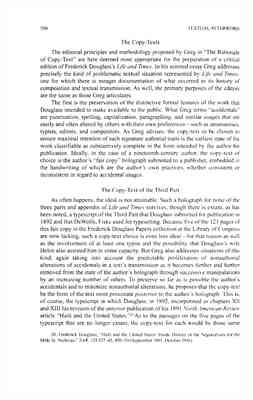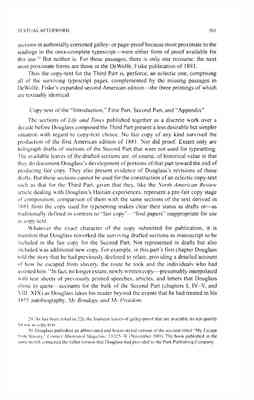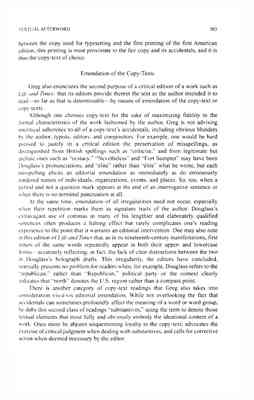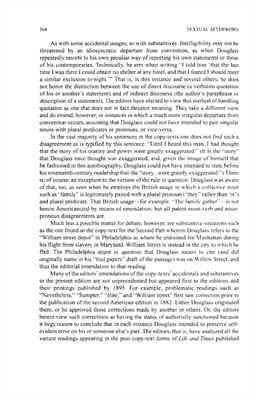Pages
16
TEXTUAL AFTERWORD
500
The Copy-Texts
The editorial principles and methodology proposed by Greg in "The Rationale of Copy-Text" are here deemed most appropriate for the preparation of a critical edition of Frederick Douglass's Life and Times. In his seminal essay Greg addresses precisely the kind of problematic textual situation represented by Life and Times: one for which there is meager documentation of what occurred in its history of composition and textual transmission. As well, the primary purposes of the editors are the same as those Greg articulates.
The first is the preservation of the distinctive formal features of the work that Douglass intended to make available to the public. What Greg terms "accidentals" are punctuation, spelling, capitalization, paragraphing, and similar usages that are easily and often altered by others with their own preferences—such as amanuenses, typists, editors, and compositors. As Greg advises, the copy-text to be chosen to ensure maximal retention of such signature authorial traits is the earliest state of the work classifiable as substantively complete in the form intended by the author for publication. Ideally, in the case of a nineteenth-century author, the copy-text of choice is the author's "fair copy" holograph submitted to a publisher, embedded in the handwriting of which are the author's own practices, whether consistent or inconsistent in regard to accidental usages.
The Copy-Text of the Third Part
As often happens, the ideal is not attainable. Such a holograph for none of the three parts and appendix of Life and Times survives, though there is extant, as has been noted, a typescript of the Third Part that Douglass submitted for publication in 1892 and that DeWolfe, Fiske used for typesetting. Because five of the 121 pages of this fair copy in the Frederick Douglass Papers collection at the Library of Congress are now lacking, such a copy-text choice is even less ideal—for that reason as well as the involvement of at least one typist and the possibility that Douglass's wife Helen also assisted him in some capacity. But Greg also addresses situations of this kind, again taking into account the predictahle proliferation of nonauthorial alterations of accidentals in a text's transmission as it becomes further and further removed from the state of the author's holograph through succcessive manipulations by an increasing number of others. To preserve so far as is possible the author's accidentals and to minimize nonauthorial alterations, he proposes that the copy-text be the form of the text most proximate posterior to the author's holograph. This is, of course, the typescript in which Douglass, in 1892, incorporated as chapters XII and XIII his revision of the anterior publication of his 1891 North American Review article "Haiti and the United States."28 As to the passages on the five pages of the typescript that are no longer extant, the copy-text for each would be those same
28. Frederick Douglass, "Haiti and the United States: Inside Histoy of the Negotiations for the Môle St. Nicholas," NAR, 153:337–45, 450–59 (Septemner 1891; October 1891).
17
TEXTUAL AFTERWORD
501
sections in authorially corrected galley- or page-proof because most proximate to the readings in the once-complete typescript—were either form of proof available for this use.29 But neither is. For those passages, there is only one recourse: the next most proximate forms are those in the DeWolfe, Fiske publication of 1893.
Thus the copy-text for the Third Part is, perforce, an eclectic one, comprising all of the surviving typescript pages, complemented by the missing passages in DeWolfe, Fiske's expanded second American edition—the three printings of which are textually identical.
Copy-text of the "Introduction," First Part, Second Part, and "Appendix"
The sections of Life and Times published together as a discrete work over a decade before Douglass composed the Third Part present a less desirable but simpler situation with regard to copy-text choice. No fair copy of any kind survived the production of the first American edition of 1881. Nor did proof. Extant only are holograph drafts of sections of the Second Part that were not used for typesetting. The available leaves of the drafted sections are, of course, of historical value in that they do document Douglass's development of portions of that part toward the end of producing fair copy. They also present evidence of Douglass's revisions of those drafts. But these sections cannot be used for the construction of an eclectic copy-text such as that for the Third Part, given that they, like the North American Review article dealing with Douglass's Haitian experiences, represent a pre-fair copy stage of composition; comparison of them with the same sections of the text derived in 1881 from the copy used for typesetting makes clear their status as drafts or—as traditionally defined in contrast to "fair copy"—"foul papers" inappropriate for use as copy-text.
Whatever the exact character of the copy submitted for publication, it is manifest that Douglass reworked the surviving drafted sections as manuscript to be included in the fair copy for the Second Part. Not represented in drafts but also included was additional new copy. For example, in this part's first chapter Douglass told the story that he had previously declined to relate, providing a detailed account of how he escaped from slavery, the route he took and the individuals who had assisted him.30 In fact, no longer extant, newly written copy—presumably interpolated with tear sheets of previously printed speeches, articles, and letters that Douglass chose to quote—accounts for the bulk of the Second Part (chapters I, IV–V, and VIII–XIX) as Douglass takes his reader beyond the events that he had treated in his 1885 autobiography, My Bondage and My Freedom.
29. As has been noted (n.22), the fourteen leaves of galley-proof that are available do not qualify for use as copy-text.
30. Douglass published an abbreviated and house-styled version of the account titled "My Escape from Slavery," Century Illustrated Magazine, 23:125–31 (November 1881). The book published in the same month contained the fuller version that Douglass had provided to the Park Publishing Company.
18
502
TEXTUAL AFTERWORD
What was not so new was the content of the whole of the First Part and of chapters II–III and VI–VII in the Second Part, as is immediately apparent when one compares those portions of Life and Times with the whole of My Bondage and My Freedom. Just how closely they are related may be seen initially at the head of the first chapter in the two-part My Bondage: there the first part is not identified as a "Part"; it is instead titled "LIFE AS A SLAVE." One finds the same in Life and Times, despite the fact that the 1881 volume's Second Part (like the Third Part in 1893) does declare itself as such on its first page. What follows the misnaming of the First Part of Life and Times is more of the same, page by page. The 1881 state of a sentence that appears in chapter XIII of the first part of My Bondage is representative. In 1855 it read, "I must now ask the reader to go with me a little back in point of time, in my humble story, and to notice another circumstance that entered into my slavery experience, and which, doubtless, has had a share in deepening my horror of slavery, and increasing my hostility toward those men and measures that practically uphold the slave system." In Life and Times this sentence illustrating Douglass's remarkable fondness for commas is a verbatim transcription save for three minor changes: in 1881 Douglass asks one to "go back with me a little" instead of "go with me a little back"; "and to notice" now reads "and notice": and "and increasing my" has become "and my."
The degree to which the First Part and four chapters of the Second Part of Life and Times are reconstitutions of the earlier narrative is even more manifest in passages containing 1855 statements that no longer made sense in 1881 and which Douglass never updated. In the same sentence in both publications, for example, he describes himself as hostile to those who "uphold" the slave system—a choice of tense that made sense in 1855 but not in the postbellum period. Douglass is twice again so inattentive in chapter XX of the First Part of Life and Times. He still refers to some would-be runaway slaves as he did in 1855, describing them as now returned to their owners. Then he continues to classify his readers as either in the nonslaveholding class or in the decades-long defunct one of slaveholders.
When preparing typesetting copy for the First Part and four chapters in the Second, Douglass possibly produced a holograph for all of the 25 chapters derived from My Bondage. But, more likely because it would have heen the most economical way to proceed in the spring of 1881, the copy comprised pages of My Bondage upon which Douglass made interlinear and marginal revisions, with intercalations of newly composed manuscript leaves when necessary.
As has already been observed, the typesetting copy for all but four chapters in the Second Part was holograph, most likely intercalated with tear sheets of previously printed texts like those from which the eulogy for President Garfield and the two speeches placed in the "Appendix" were typeset.
Whatever the composition of the copy submitted to the Park Publishing Company, and however eclectic its character, nothing of the kind is available for consideration as copy-text. Since there also survive no forms of the text intermediate
19
503
TEXTUAL AFTERWORD
between the copy used for typesetting and the first printing of the first American edition, this printing is most proximate to the fair copy and its accidentals, and it is thus the copy-text of choice.
Emendation of the Copy-Texts
Greg also enunciates the second purpose of a critical edition of a work such as Life and Times: that its editors provide therein the text as the author intended it to read—so far as that is determinable—by means of emendation of the copy-text or copy-texts.
Although one chooses copy-text for the sake of maximizing fidelity to the formal characteristics of the work fashioned by the author, Greg is not advising uncritical adherence to all of a copy-text's accidentals, including obvious blunders by the author, typists, editors, and compositors. For example, one would be hard pressed to justify in a critical edition the preservation of misspellings, as distinguished from British spellings such as "criticise," and from legitimate but archaic ones such as "ecstacy." "Nevetheless" and "Fort Sumpter" may have been Douglass's pronunciations, and "èlite" rather than "élite" what he wrote, but each misspelling elicits an editorial emendation as immediately as do erroneously rendered names of individuals, organizations, events, and places. So, too, when a period and not a question mark appears at the end of an interrogative sentence or when there is no terminal punctuation at all.
At the same time, emendation of all irregularities need not occur, especially when their repetition marks them as signature traits of the author. Douglass's extravagant use of commas in many of his lengthier and elaborately qualified sentences often produces a halting effect but rarely complicates one's reading experience to the point that it warrants an editorial intervention. One may also note in this edition of Life and Times that, as in its nineteenth-century manifestations, first letters of the same words repeatedly appear in both their upper- and lowercase forms—accurately reflecting, in fact, the lack of clear distinctions between the two in Douglass's holograph drafts. This irregularity, the editors have concluded, formally presents no problem for readers when, for example, Douglass refers to the "republican," rather than "Republican," political party or the context clearly indicates that "north" denotes the U.S. region rather than a compass point.
There is another category of copy-text readings that Greg also takes into consideration vis-à-vis editorial emendation. While not overlooking the fact that accidentals can sometimes profoundly affect the meaning of a word or word group, he dubs this second class of readings "substantives," using the term to denote those textual elements that most fully and obviously embody the ideational content of a work. Once more he abjures unquestioning loyalty to the copy-text, advocates the exercise of critical judgment when dealing with substantives, and calls for corrective action when deemed necessary by the editor.
20
504
TEXTUAL AFTERWORD
As with some accidental usages, so with substantives. Intelligibility may not be threatened by an idiosyncratic departure from convention, as when Douglass repeatedly resorts to his own peculiar way of reporting his own statements or those of his contemporaries. Technically, he errs when writing "I told him 'that the last time I was there I could obtain no shelter at any hotel, and that I feared I should meet a similar exclusion to-night.'" That is, in this instance and several others, he does not honor the distinction between the use of direct discourse (a verbatim quotation of his or another's statement) and of indirect discourse (the author 's paraphrase or description of a statement). The editors have elected to view this method of handling quotation as one that does not in fact threaten meaning. They take a different view and do emend, however, in instances in which a much more irregular departure from convention occurs, assuming that Douglass could not have intended to pair singular nouns with plural predicates or pronouns, or vice-versa.
In the vast majority of his sentences in the copy-texts one does not find such a disagreement as is typified by this sentence: "Until I heard this man, I had thought that the story of his oratory and power were greatly exaggerated." (It is the "story" that Douglass once thought was exaggerated; and, given the image of himself that he fashioned in this autobiography, Douglass could not have intended to state before his nineteenth-century readership that the "story . . . were greatly exaggerated.") There is, of course, an exception to the version of the rule in question. Douglass was aware of that, too, as seen when he employs the British usage in which a collective noun such as "family" is legitimately paired with a plural pronoun ("'they" rather than "it") and plural predicate. That British usage—for example, "The family gather"—is not herein Americanized by means of emendation; but all patent noun-verb and nounpronoun disagreements are.
Much less a possible matter for debate, however, are substantive situations such as the one found in the copy-text for the Second Part wherein Douglass refers to the "William street depot" in Philadelphia as where he entrained for Manhattan during his flight from slavery in Maryland. William Street is instead in the city to which he fled. The Philadelphia depot in question that Douglass meant to cite (and did originally name in his "foul papers" draft of the passage) was on Willow Street, and thus the editorial emendation to that reading.
Many of the editors' emendations of the copy-texts' accidentals and substantives in the present edition are not unprecedented but appeared first in the editions and their printings published by 1895. For example, problematic readings such as "Nevetheless," "Sumpter," "èlite," and "William street" first saw correction prior to the publication of the second American edition in 1882. Either Douglass originated them, or he approved those corrections made by another or others. Or, the editors herein view such corrections as having the status of authorially sanctioned because it begs reason to conclude that in each instance Douglass intended to preserve selfevident error on his or someone else's part. The editors, that is, have analyzed all the variant readings appearing in the post-copy-text forms of Life and Times published




